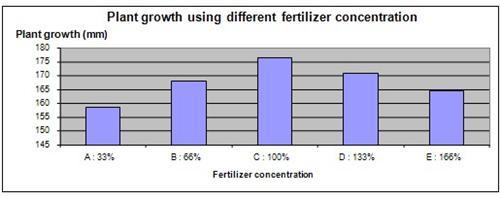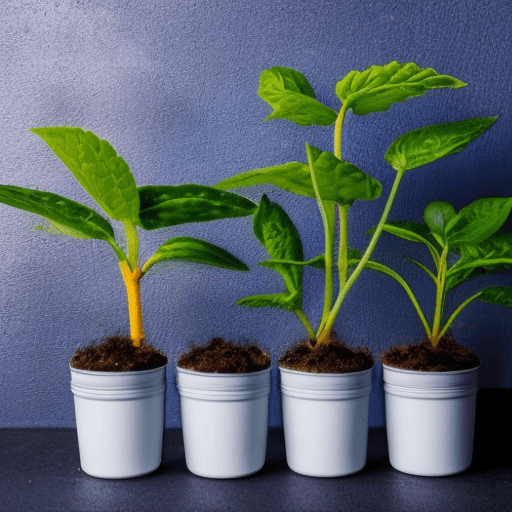| Complexity level: | 7 |
| Project cost ($): | 25 |
| Time required: | 1 day to prepare, 10 days for observation |
| Material availability: | 1 day to prepare, 10 days for observation |
| Safety concerns: | Some fertilizers react to solvents - perform the experiment in a well ventilated place and add the fertilizer slowly. |
Hypothesis
Watering the plant with too little or too much fertilizer will slow down plant growth.
Overview
Fertilizers
Plants need nutrients to grow and fertilizers are a good source of nutrients that may be lacking in the soil. However too much of anything is not a good thing.
Plants absorb water from the soil into the roots through a process called osmosis. This process will require the salt content inside the roots to be higher than the salt content of the soil. As a result, the water molecules will migrate from the soil into the roots in order to balance the salt level in the soil and in the roots.
Using too much fertilizer will increase the salt content of the soil. If the salt content of the soil becomes higher than the salt content of the roots, the water molecules will migrate out of the root into the soil causing root burn. This will cause the plant to grow more slowly, become dehydrated and eventually die.
Too little fertilizer will cause the plants not being able to grow at the optimal speed due to the lack of nutrients in the soil.
Therefore using the correct amounts of fertilizer recommended by the manufacturer is the safest way for the plants to grow healthily.
Scientific Terms
Materials
The materials required for this science fair project:
- 1 packet of radish seeds
- 15 plastic pots
- Soil required for 15 pots
- Hasta Gro fertilizer
- Tap water
- Ruler (1 meter)
- 5 plastic containers
- 1 measurement cup
Procedure
1. For this experiment, the independent variable is the concentration of fertilizer in the water. The dependent variable is the growth of the radish plant. This is determined by measuring the average height of the 3 plants in each group and calculating the average height. The constants (control variables) are the amount of water and the type of plant used.
2. The 15 pots are filled with the same amount of soil. One radish seed is placed in each pot. (More than one radish seed can be used in each pot in case some of the seeds do not germinate. Once they start to geminate, remove the unwanted plants from the pot)
3. The pots are divided into 5 groups with 3 plants in each group. They are labeled as group A, group B, group C, group D and group E. The pots are watered 2 times a day according to the concentrations recommended below.
a. Group A plants are watered using 33% of recommended concentration of fertilizers
b. Group B plants are watered using 66% of recommended concentration of fertilizers
c. Group C plants are watered using 100% of recommended concentration of fertilizers
d. Group D plants are watered using 133% of recommended concentration of fertilizers
e. Group E plants are watered using 166% of recommended concentration of fertilizers
4. The height of the plants is measured on the 10th day and the average is calculated for each group.

Results
It is observed that the plants in group C which had followed the recommended concentration of fertilizer had the fastest growth in 10 days. The plants in group A and group E which used concentration of fertilizers either too little or too much had the slowest growth in the 10 days.
Use the table below to record the radish plants average height (in mm) measured after 10 days.
Plant Group |
Fertilizer concentration -100% recommended level |
Plant height measure after 10 days (mm) |
Average Height (mm) |
||
1 |
2 |
3 |
|||
A |
33% |
478 |
484 |
466 |
476 |
B |
66% |
496 |
512 |
504 |
504 |
C |
100% |
524 |
538 |
528 |
530 |
D |
133% |
513 |
518 |
508 |
513 |
E |
166% |
486 |
494 |
502 |
494 |
The graph below represents the results of our science project experiment.

Conclusion
The hypothesis that watering plants with too little or too much fertilizer will slow down plant growth is proven to be true.
Using the correct amounts of fertilizer is important to optimize the yield of the garden or the farms. Sometimes continual use of fertilizer will cause nutrients and salt to accumulate in the soil over a period of time. Therefore, using fertilizers once a week instead of daily or having the soil tested may be recommended to improve the yield and protect the crops.
Also consider
What would happen if the experiment was repeated using different types of plants like bamboo or beans?
The experiment can be repeated using different brands of fertilizer.
References
A great alternative to chemical fertilizers – Hasta Gro organic food plant - http://www.epinions.com/review/Hasta_Gro_POrganic_Plant_Food_Gallon/content_44027628436
How do the amounts of fertilizer affect plant growth? - http://www.madsci.org/posts/archives/2002-04/1019088560.Bt.r.html

